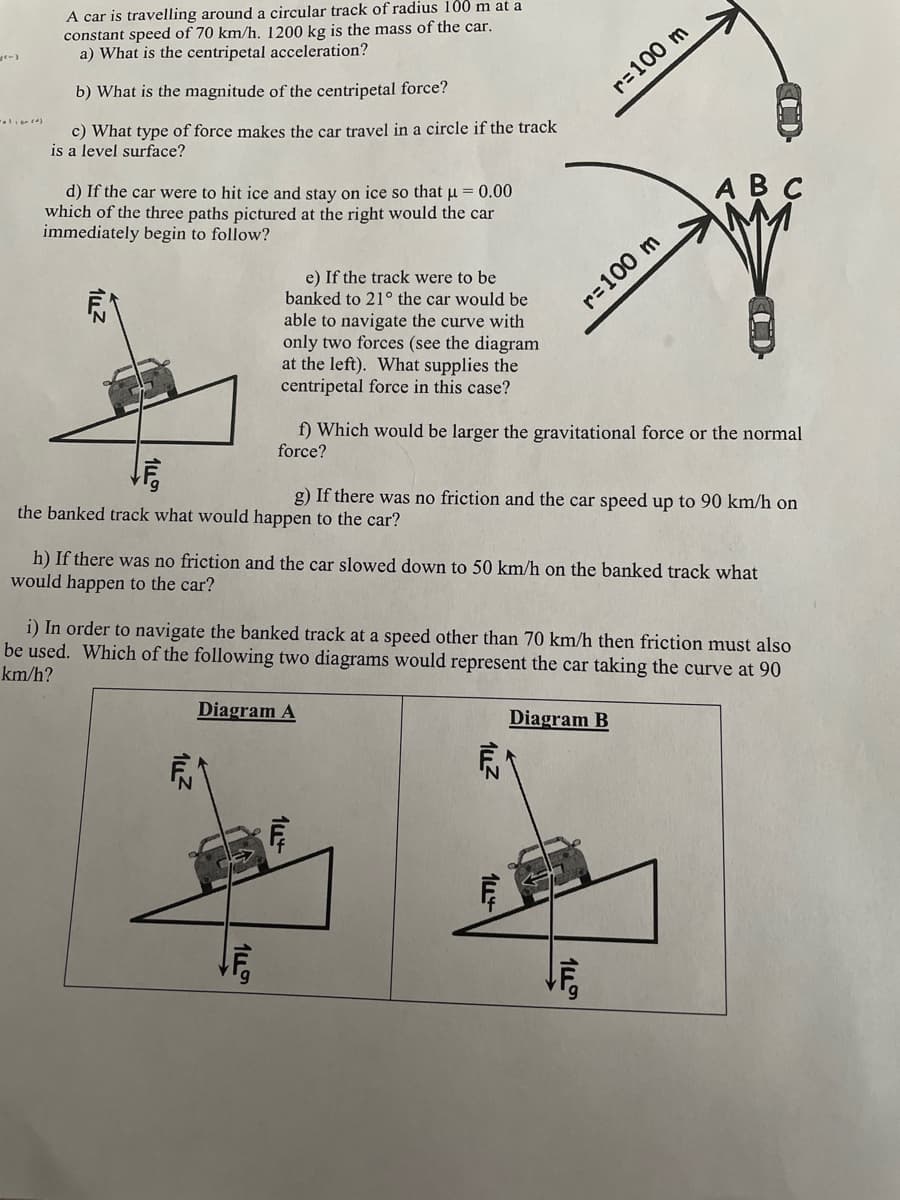A car is travelling around a circular track of radius 100 m at a constant speed of 70 km/h. 1200 kg is the mass of the car. a) What is the centripetal acceleration? b) What is the magnitude of the centripetal force? r=100 m c) What type of force makes the car travel in a circle if the track is a level surface? A BC d) If the car were to hit ice and stay on ice so that u = 0.00 which of the three paths pictured at the right would the car immediately begin to follow? e) If the track were to be banked to 21° the car would be able to navigate the curve with only two forces (see the diagram at the left). What supplies the centripetal force in this case? f) Which would be larger the gravitational force or the normal force? g) If there was no friction and the car speed up to 90 km/h on the banked track what would happen to the car? h) If there was no friction and the car slowed down to 50 km/h on the banked track what would happen to the car? i) In order to navigate the banked track at a speed other than 70 km/h then friction must also be used. Which of the following two diagrams would represent the car taking the curve at 90 km/h? Diagram A Diagram B r=100 m
A car is travelling around a circular track of radius 100 m at a constant speed of 70 km/h. 1200 kg is the mass of the car. a) What is the centripetal acceleration? b) What is the magnitude of the centripetal force? r=100 m c) What type of force makes the car travel in a circle if the track is a level surface? A BC d) If the car were to hit ice and stay on ice so that u = 0.00 which of the three paths pictured at the right would the car immediately begin to follow? e) If the track were to be banked to 21° the car would be able to navigate the curve with only two forces (see the diagram at the left). What supplies the centripetal force in this case? f) Which would be larger the gravitational force or the normal force? g) If there was no friction and the car speed up to 90 km/h on the banked track what would happen to the car? h) If there was no friction and the car slowed down to 50 km/h on the banked track what would happen to the car? i) In order to navigate the banked track at a speed other than 70 km/h then friction must also be used. Which of the following two diagrams would represent the car taking the curve at 90 km/h? Diagram A Diagram B r=100 m
College Physics
10th Edition
ISBN:9781285737027
Author:Raymond A. Serway, Chris Vuille
Publisher:Raymond A. Serway, Chris Vuille
Chapter7: Rotational Motion And The Law Of Gravity
Section: Chapter Questions
Problem 29P: A woman places her briefcase on the backseat of her car. As she drives to work, the car negotiates...
Related questions
Question
Do d,ef,g,h

Transcribed Image Text:A car is travelling around a circular track of radius 100 m at a
constant speed of 70 km/h. 1200 kg is the mass of the car.
a) What is the centripetal acceleration?
b) What is the magnitude of the centripetal force?
r=100 m
c) What type of force makes the car travel in a circle if the track
is a level surface?
d) If the car were to hit ice and stay on ice so that u = 0.00
which of the three paths pictured at the right would the car
immediately begin to follow?
АВС
e) If the track were to be
banked to 21° the car would be
able to navigate the curve with
only two forces (see the diagram
at the left). What supplies the
centripetal force in this case?
r=100 m
f) Which would be larger the gravitational force or the normal
force?
the banked track what would happen to the car?
g) If there was no friction and the car speed up to 90 km/h on
h) If there was no friction and the car slowed down to 50 km/h on the banked track what
would happen to the car?
i) In order to navigate the banked track at a speed other than 70 km/h then friction must also
be used. Which of the following two diagrams would represent the car taking the curve at 90
km/h?
Diagram A
Diagram B
Expert Solution
This question has been solved!
Explore an expertly crafted, step-by-step solution for a thorough understanding of key concepts.
Step by step
Solved in 2 steps with 2 images

Knowledge Booster
Learn more about
Need a deep-dive on the concept behind this application? Look no further. Learn more about this topic, physics and related others by exploring similar questions and additional content below.Recommended textbooks for you

College Physics
Physics
ISBN:
9781285737027
Author:
Raymond A. Serway, Chris Vuille
Publisher:
Cengage Learning

College Physics
Physics
ISBN:
9781305952300
Author:
Raymond A. Serway, Chris Vuille
Publisher:
Cengage Learning

Principles of Physics: A Calculus-Based Text
Physics
ISBN:
9781133104261
Author:
Raymond A. Serway, John W. Jewett
Publisher:
Cengage Learning

College Physics
Physics
ISBN:
9781285737027
Author:
Raymond A. Serway, Chris Vuille
Publisher:
Cengage Learning

College Physics
Physics
ISBN:
9781305952300
Author:
Raymond A. Serway, Chris Vuille
Publisher:
Cengage Learning

Principles of Physics: A Calculus-Based Text
Physics
ISBN:
9781133104261
Author:
Raymond A. Serway, John W. Jewett
Publisher:
Cengage Learning

University Physics Volume 1
Physics
ISBN:
9781938168277
Author:
William Moebs, Samuel J. Ling, Jeff Sanny
Publisher:
OpenStax - Rice University

College Physics
Physics
ISBN:
9781938168000
Author:
Paul Peter Urone, Roger Hinrichs
Publisher:
OpenStax College

Physics for Scientists and Engineers with Modern …
Physics
ISBN:
9781337553292
Author:
Raymond A. Serway, John W. Jewett
Publisher:
Cengage Learning